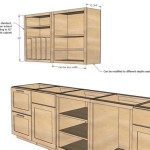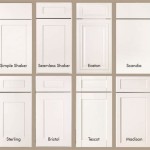How to Get Stains Out of White Kitchen Cabinets
White kitchen cabinets are a popular choice for homeowners due to their bright and airy appearance. However, they can be prone to staining, especially with regular use. From grease splatters to spills and fingerprints, stains can detract from the overall cleanliness and aesthetic of your kitchen. Luckily, with the right cleaning methods and a bit of elbow grease, you can remove most stains and restore your white cabinets to their original glory.
Understanding the Types of Stains
Before tackling any stain, it's crucial to understand what type of stain you're dealing with. This will help determine the best cleaning method and prevent further damage. Here are some common types of stains found on white kitchen cabinets:
- Grease and oil stains: These are often caused by cooking splatters and can be difficult to remove if left untreated.
- Food and beverage stains: Stains from coffee, tea, wine, and other food items can leave unsightly marks on white cabinets.
- Water stains: Watermarks can appear on cabinets due to condensation or spills, especially in humid environments.
- Ink and marker stains: These can be particularly challenging to remove but are often caused by children or accidents.
- Scratch marks: Scratches can occur from rough cleaning tools or mishandling and can be difficult to eliminate completely.
General Cleaning Techniques
Before attempting stain removal, start with a general cleaning to remove dirt and grime. Use a mild dish soap and warm water solution with a soft cloth or sponge. Work in a circular motion, paying attention to areas prone to staining, such as around handles, knobs and doors. Avoid using abrasive cleaners or scrubbers that can scratch the cabinet surface.
For more stubborn stains, you can try the following methods:
- Baking soda paste: Create a paste with baking soda and water. Apply it to the stain and let it sit for a few minutes before scrubbing gently with a soft-bristled brush. Rinse thoroughly with warm water.
- White vinegar: White vinegar is a natural cleaner that can effectively remove grease and grime. Dilute white vinegar with water in a ratio of 1:1 and apply it to the stain with a soft cloth. Let it sit for a few minutes before rinsing with warm water.
- Lemon juice: Lemon juice acts as a natural bleaching agent and can help remove light stains. Apply a few drops of lemon juice to the stain and let it sit for a few minutes before rinsing with warm water.
Specific Stain Removal Methods
For tougher stains, you may need more specific solutions. Here are some methods for removing common stains on white kitchen cabinets:
Grease and Oil Stains
For grease and oil stains, try a degreaser or a mixture of baking soda and dish soap. Apply the cleaner to the stain and let it sit for a few minutes before scrubbing with a soft-bristled brush. Rinse thoroughly with warm water. If the stain persists, repeat the process or consider using a commercial kitchen degreaser.
Food and Beverage Stains
Coffee, tea, and wine stains can be removed with a solution of white vinegar and baking soda. Apply the mixture to the stain and let it sit for a few minutes before scrubbing with a soft-bristled brush. Rinse thoroughly with warm water. For stubborn stains, you can try soaking a cotton ball in rubbing alcohol and dabbing the stain until it disappears.
Water Stains
Water stains can often be removed with a mixture of white vinegar and water or a commercial water stain remover. Apply the cleaner to the stain and let it sit for a few minutes before scrubbing with a soft-bristled brush. Rinse thoroughly with warm water. To prevent future water stains, dry spills immediately and consider using a dehumidifier to reduce condensation.
Ink and Marker Stains
Ink and marker stains can be challenging to remove. If possible, try using a magic eraser to remove the stain. If that fails, you can try soaking a cotton ball in rubbing alcohol or nail polish remover and dabbing the stain gently. Always test the cleaner on an inconspicuous area first to ensure it does not damage the cabinet finish.
Scratch Marks
Scratches can be difficult to remove completely, but you can try using a furniture polish or a wood filler to minimize their appearance. Choose a polish or filler that matches the color of your cabinets. Apply a thin layer of the product to the scratch and let it dry completely. If the scratch is deep, you may need to contact a professional to repair it.
Remember that the best way to prevent stains on white kitchen cabinets is to clean them regularly. Wipe down spills immediately and avoid using harsh cleaners or abrasives. With regular cleaning and proper stain removal techniques, you can keep your white kitchen cabinets looking clean and bright for years to come.

How To Clean White Kitchen Cabinets 3 Best Ways Avoid Abbotts At Home

How To Clean White Kitchen Cabinets 3 Best Ways Avoid Abbotts At Home

3 Super Easy Ways To Clean White Kitchen Cabinets And Avoid

How To Clean Painted Kitchen Cabinets By Kayla Payne

How To Clean White Kitchen Cabinets Cabinetselect Com

How To Clean And Maintain White Kitchen Cabinets Unique Design Blog

How To Clean White Kitchen Cabinets Cabinetselect Com

What S The Best Way To Clean Your White Kitchen Cabinets Ag Williams

How To Get Rid Of Kitchen Cabinet Stains

How To Clean White Kitchen Cabinets Cabinetselect Com








